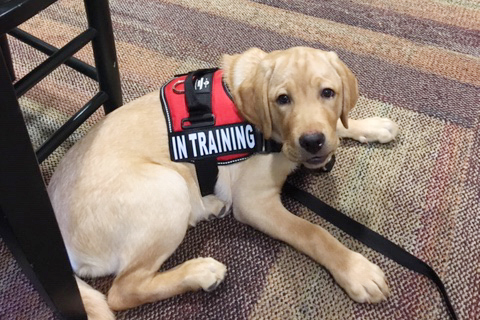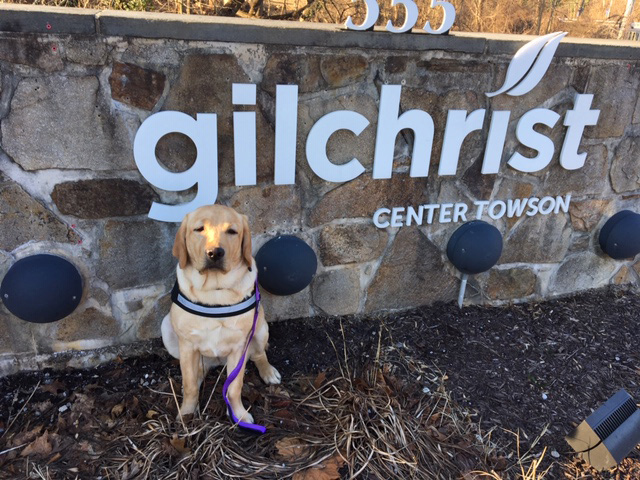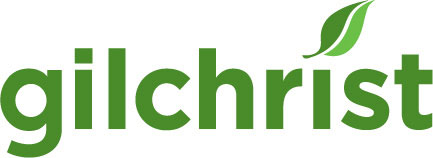Gilchrist’s Own Homegrown Therapy Dog
Meet Cherish, a 14-week-old Labrador Retriever who has become the most popular new team member at Gilchrist!
Cherish (named by the Gilchrist staff) will be raised in the organization to ultimately greet patients and visitors at Gilchrist Center Towson as our very own therapy dog!
What is a Therapy Dog?
Therapy dogs are dogs trained to provide comfort and affection to people in settings such as nursing homes, classrooms, assisted living centers, funeral homes and hospices. The main job of a therapy dog is to improve the lives of others. A dog can provide joy, comfort and a calming presence to people who are feeling stressed, lonely, scared or sad.
How Will Cherish Become a Therapy Dog?

Becoming a therapy dog takes time, hard work and a lot of dedication, as the training and testing preparation is rigorous.
The first step along the path of therapy dog certification is the American Kennel Club (AKC) Canine Good Citizen certification. This is a 10-step test performed by an AKC evaluator and will require Cherish to demonstrate confidence and control in specific situations.
Once Cherish has passed the Canine Good Citizen certification, she will begin earning her therapy dog title, which is based on the number of visits she makes. Each day at Gilchrist Center Towson counts as one “visit” towards her title. Earning the highest title, “AKC Therapy Dog Distinguished,” will require completing 400 visit days.
What Makes Cherish the Right Pup for the Job?
Cherish possesses the qualities that make a good therapy dog, which include being friendly, patient, confident, gentle and at ease in all situations. She enjoys being petted, cuddled and handled by people, even when they are unfamiliar to her.
As we train Cherish for her certification, we also prepare her for the unique environment at Gilchrist Center Towson. Cherish will need to be comfortable around medical equipment such as wheelchairs, walkers and scooters, which could be stationary or mobile. She will need to understand the difference between being invited onto a patient’s bed and staying on the floor if that invitation does not come. She will have to sit patiently, reading visitors’ and staff’s body language and waiting for an invitation to visit with them.
The Impact Cherish is Having
Even though we are in the infancy of training, Cherish is already making a positive impact on the Gilchrist staff she encounters as she comes to work each day. When Cherish walks into a room, you can immediately feel a change in the mood. Suddenly, smiles spread across everyone’s faces, while some drop to the floor to greet her on her level as she rolls over for a belly rub. People stop what they are doing for a chance to pat her on the head or get a puppy kiss. When they get back to work they do so with a happy heart and a wide grin.
As we enter this uncharted territory, I get many questions from employees, such as “Will the other inpatient units also be getting their own therapy dog?” “Will the dog live at the unit or go home every night?” Or “If she goes home, will it be with one person or a variety of people?” Most of the time, my answer is, “We are taking it one day at a time and will do what is best for Cherish and those she serves.”
Check back for updates on the adventures of Cherish and the great work she will certainly accomplish!
To learn more about the care and services Gilchrist provides, visit gilchristcares.org.
Update on Cherish

Cherish will now be spending her days at Gilchrist Center Towson as she works to complete her training as the center’s therapy dog. She is eager to learn and support the patients and families there! Every morning, she visits patients who would like to spend a few moments with her and then she’s off to learn the ins and outs of hospice care from the managers. Little by little, she is given more responsibility and is even expected to attend staff meetings!



2 thoughts on “Gilchrist’s Own Homegrown Therapy Dog”
I respect everything that you have written in this blog. Please continue to provide wisdom to more people like me.
What a heartwarming article on the role of therapy dogs, particularly your homegrown star! It’s truly inspiring to read about the tangible emotional and psychological benefits these wonderful animals can provide. The work you’re doing is invaluable, and it’s clear that the presence of a therapy dog like yours can make a significant difference in patient care. Keep up the excellent work!